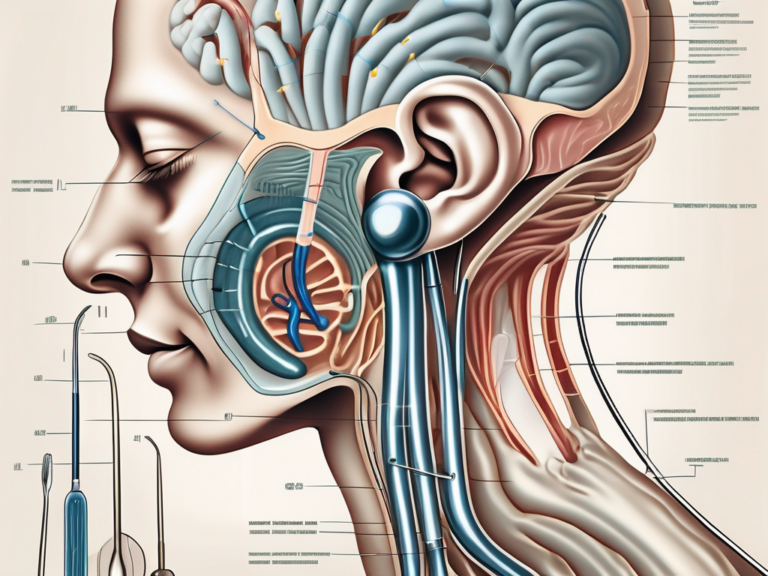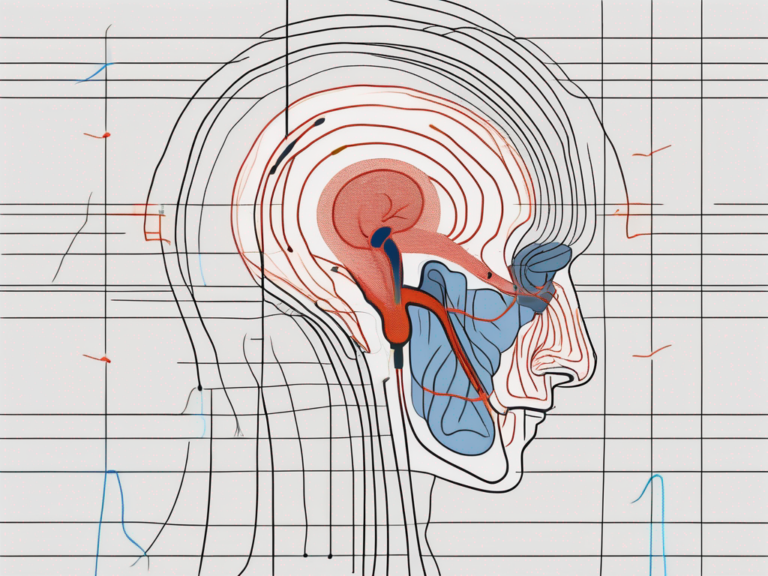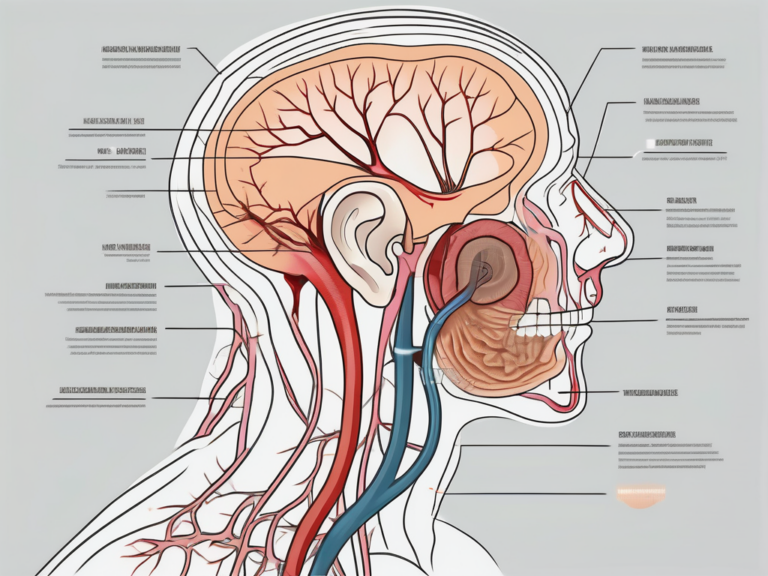The vestibular nerve is a crucial component of the human body’s sensory system, responsible for maintaining balance and spatial orientation. Understanding the role and significance of the vestibular nerve requires delving into its definition, function, and anatomy.
Understanding the Vestibular Nerve
Definition and Function of the Vestibular Nerve
The vestibular nerve, also known as the auditory vestibular nerve or the eighth cranial nerve, is one of the two branches that form the vestibulocochlear nerve. It works in tandem with the cochlear nerve to transmit sensory information from the inner ear to the brain.
Specifically, the vestibular nerve carries sensory signals from the vestibular organs of the inner ear, which include the semicircular canals, the utricle, and the saccule. These organs are responsible for detecting changes in head position and motion, helping us maintain balance and equilibrium.
When we move our heads, the fluid within the semicircular canals shifts, stimulating hair cells that are connected to the vestibular nerve. These hair cells convert the mechanical movement into electrical signals, which are then transmitted through the vestibular nerve to the brain.
The vestibular nerve plays a crucial role in our ability to navigate the world around us. It allows us to walk, run, and maintain our balance, even on uneven surfaces. Without the vestibular nerve, simple tasks like standing upright or turning our heads would become incredibly challenging.
Anatomy of the Vestibular Nerve
The vestibular nerve originates from the vestibular ganglion, which is located within the internal auditory canal of the temporal bone. From there, it travels alongside the cochlear nerve and enters the brainstem, where it plays a vital role in relaying sensory information to various regions of the brain.
Within the brainstem, the vestibular nerve connects to the vestibular nuclei, a collection of nuclei that process and integrate the incoming sensory signals. These nuclei are responsible for interpreting the information received from the vestibular organs and coordinating appropriate responses.
Once the sensory signals are processed in the vestibular nuclei, they are sent to various regions of the central nervous system. One important destination is the cerebellum, which is involved in coordinating voluntary movements and maintaining balance. The vestibular nerve ensures that the cerebellum receives accurate and timely information about head position and motion.
In addition to the cerebellum, the vestibular nerve also sends information to the cerebral cortex, the outer layer of the brain responsible for higher cognitive functions. This allows us to consciously perceive our body’s position in space and make adjustments accordingly.
Overall, the anatomy of the vestibular nerve is intricately connected to the functioning of the inner ear, brainstem, cerebellum, and cerebral cortex. It is through this complex network that the vestibular nerve enables us to maintain balance, coordinate movements, and navigate the world with ease.
The Role of the Vestibular Nerve in the Human Body
Connection to the Ear and Brain
The vestibular nerve’s connection to both the ear and the brain is fundamental to its role in maintaining balance and spatial orientation. As sensory information is picked up by the vestibular organs in the inner ear, it is transmitted through the vestibular nerve to the brainstem for further processing.
The vestibular nerve is a branch of the vestibulocochlear nerve, also known as the eighth cranial nerve. It emerges from the inner ear, specifically the vestibular labyrinth, which is responsible for detecting changes in head position and movement. This labyrinth consists of three semicircular canals and two otolith organs, the utricle and saccule.
Within the semicircular canals, there are specialized hair cells that are sensitive to rotational movements of the head. When the head rotates, the fluid within these canals also moves, causing the hair cells to bend. This bending of the hair cells triggers electrical signals that are transmitted through the vestibular nerve.
The utricle and saccule, on the other hand, detect linear acceleration and changes in head position relative to gravity. They contain tiny calcium carbonate crystals called otoliths, which are embedded in a gelatinous substance. When the head moves, the otoliths shift, bending the hair cells and generating electrical signals that are sent through the vestibular nerve.
From the brainstem, the processed information is shared with other parts of the brain, such as the cerebellum and the cerebral cortex. These regions play crucial roles in coordinating movements, perceiving spatial relationships, and generating appropriate motor responses.
Importance in Balance and Spatial Orientation
The importance of the vestibular nerve in balance and spatial orientation cannot be overstated. Without the proper functioning of this nerve, individuals may experience a range of debilitating symptoms, such as vertigo, dizziness, and an impaired ability to maintain posture.
Vertigo is a sensation of spinning or whirling, often accompanied by nausea and loss of balance. It can be caused by various factors, including inflammation of the vestibular nerve, inner ear infections, or even certain medications. When the vestibular nerve is affected, it can disrupt the transmission of signals related to head movements and lead to a distorted perception of motion.
Dizziness, on the other hand, refers to a general feeling of lightheadedness or unsteadiness. It can be caused by a variety of factors, including low blood pressure, dehydration, or inner ear disorders. When the vestibular nerve is involved, it can result in a sensation of imbalance, making it difficult for individuals to walk or perform daily activities.
Furthermore, the vestibular nerve contributes to our sense of spatial orientation, enabling us to perceive our position in relation to gravity and to navigate our surroundings accurately. This information allows us to perform everyday tasks with ease, such as walking, running, and even simply staying upright.
When the vestibular nerve is functioning properly, it provides the brain with crucial information about the body’s position and movement in space. This allows the brain to make precise adjustments to posture and muscle activity, ensuring that we maintain our balance and stability.
In summary, the vestibular nerve plays a vital role in maintaining balance and spatial orientation. Its connection to the ear and brain allows for the transmission of sensory information, which is essential for coordinating movements and perceiving spatial relationships. Without the proper functioning of this nerve, individuals may experience symptoms such as vertigo, dizziness, and an impaired ability to maintain posture. Understanding the importance of the vestibular nerve helps us appreciate the intricate mechanisms that contribute to our sense of balance and orientation in the world.
Disorders Related to the Vestibular Nerve
The vestibular nerve plays a crucial role in maintaining our sense of balance and spatial orientation. When this nerve is affected by certain disorders, it can have a profound impact on an individual’s quality of life. Symptoms can vary widely, but often include vertigo (a spinning sensation), dizziness, imbalance, nausea, and difficulty concentrating.
However, it is important to note that experiencing these symptoms does not necessarily indicate a problem with the vestibular nerve itself. Other conditions, such as inner ear infections, Meniere’s disease, or certain medication side effects, can also cause similar symptoms. Therefore, consulting with a healthcare professional is crucial for an accurate diagnosis.
Symptoms of Vestibular Disorders
When the vestibular nerve is affected, individuals may experience a range of symptoms that can significantly impact their daily lives. Vertigo, one of the most common symptoms, can be described as a sensation of spinning or whirling, making it difficult to maintain balance and orientation. This sensation can be triggered by simple movements, such as turning the head or getting out of bed.
In addition to vertigo, dizziness is another prevalent symptom of vestibular disorders. Individuals may feel lightheaded or unsteady, as if the ground beneath them is constantly shifting. This can lead to a fear of falling and a reluctance to engage in activities that require balance, such as walking or driving.
Imbalance is another common symptom that individuals with vestibular disorders may experience. They may feel as if they are constantly swaying or being pulled in one direction, making it challenging to maintain a stable posture. This can result in a higher risk of falls and injuries.
Furthermore, nausea is a frequent companion of vestibular disorders. The constant sensation of movement and imbalance can trigger feelings of queasiness and an upset stomach. This can be particularly debilitating, as it can lead to a loss of appetite and difficulty in performing daily tasks.
Lastly, difficulty concentrating is a symptom that often accompanies vestibular disorders. The constant sensory disruptions caused by the affected vestibular nerve can make it challenging to focus on tasks, leading to decreased productivity and increased frustration.
Common Vestibular Disorders and Their Causes
Vestibular disorders can arise from various causes, each with its specific impact on the vestibular nerve. One common disorder is vestibular neuritis, an inflammation of the vestibular nerve typically caused by viral infections. This inflammation disrupts the transmission of sensory signals, leading to dizziness and imbalance. It can be a result of a viral infection, such as the herpes virus or respiratory tract infections.
Another common vestibular condition is benign paroxysmal positional vertigo (BPPV), which involves the displacement of tiny calcium crystals within the inner ear. These crystals, known as otoconia, are normally present in the inner ear and play a crucial role in detecting head movements. However, in BPPV, these crystals become dislodged and migrate into the semicircular canals, interfering with the normal functioning of the vestibular organs. This displacement can be triggered by certain head movements, such as rolling over in bed or looking up, resulting in vertigo and dizziness.
Other causes of vestibular disorders include Meniere’s disease, a chronic condition characterized by recurring episodes of vertigo, hearing loss, tinnitus (ringing in the ears), and a feeling of fullness in the affected ear. The exact cause of Meniere’s disease is still unknown, but it is believed to be related to an abnormal buildup of fluid in the inner ear.
In some cases, vestibular disorders can also be caused by head trauma, such as a concussion or whiplash injury. The sudden impact can damage the delicate structures of the inner ear, including the vestibular nerve, leading to persistent dizziness and imbalance.
Overall, disorders related to the vestibular nerve can have a significant impact on an individual’s well-being. Understanding the symptoms and causes of these disorders is crucial for accurate diagnosis and effective management of the condition.
Diagnosis and Treatment of Vestibular Nerve Disorders
Vestibular nerve disorders can be debilitating conditions that affect a person’s balance and coordination. Accurately diagnosing these disorders is crucial in order to provide appropriate treatment and improve quality of life. A comprehensive evaluation conducted by a healthcare professional with expertise in vestibular disorders is often necessary to determine the underlying cause and develop an effective treatment plan.
Diagnostic Procedures for Vestibular Disorders
When it comes to diagnosing vestibular nerve disorders, healthcare professionals employ various diagnostic procedures to gather essential information. These procedures include a detailed medical history, physical examination, and specific vestibular tests.
During the medical history assessment, the healthcare professional will inquire about the patient’s symptoms, their duration, and any triggers or patterns associated with them. This information can provide valuable clues about the nature and possible causes of the vestibular disorder.
The physical examination may involve assessing the patient’s balance, coordination, and eye movements. Abnormalities in these areas can indicate dysfunction in the vestibular system. Additionally, the healthcare professional may perform specific tests, such as the Dix-Hallpike maneuver, to provoke symptoms and further evaluate the patient’s condition.
Some of the vestibular tests involve assessing eye movements, such as electronystagmography (ENG) or video-oculography (VOG). These tests can help determine whether the vestibular organs, including the vestibular nerve, are functioning properly. ENG measures involuntary eye movements, while VOG uses video technology to track eye movements accurately.
In addition to these tests, imaging studies, such as magnetic resonance imaging (MRI), may be ordered to rule out other possible causes of the symptoms, such as tumors or structural abnormalities in the vestibular system.
Treatment Options and Rehabilitation for Vestibular Disorders
Once a vestibular nerve disorder is diagnosed, the next step is to develop an appropriate treatment plan. The treatment options for these disorders depend on the specific underlying cause and the severity of the symptoms.
In some cases, medications may be prescribed to alleviate symptoms such as vertigo or nausea. These medications can help manage the symptoms and improve the patient’s overall quality of life. However, it is important to note that medications alone may not address the root cause of the vestibular disorder and may be used in conjunction with other treatment modalities.
Another treatment option for vestibular nerve disorders is vestibular rehabilitation therapy. This specialized form of therapy aims to retrain the brain to compensate for any vestibular dysfunction. It involves a series of exercises and activities designed to improve balance, coordination, and reduce dizziness. Vestibular rehabilitation therapy is typically tailored to the individual needs of the patient and may be conducted by a physical therapist or occupational therapist.
It is important to note that treatment options should be discussed with a healthcare professional familiar with vestibular disorders. Each case is unique, and a tailored approach is necessary to address individual symptoms and needs effectively. The healthcare professional will consider factors such as the patient’s medical history, severity of symptoms, and overall health when developing a treatment plan.
In conclusion, accurate diagnosis and appropriate treatment are essential for individuals with vestibular nerve disorders. Through a comprehensive evaluation and the utilization of various diagnostic procedures, healthcare professionals can determine the underlying cause of the disorder. Treatment options, such as medications and vestibular rehabilitation therapy, can then be implemented to alleviate symptoms and improve the patient’s quality of life.
Recent Advances in Vestibular Nerve Research
The vestibular nerve, responsible for maintaining balance and spatial orientation, has been the subject of extensive research in recent years. Scientists and medical professionals have made significant advancements in understanding and treating vestibular nerve disorders, leading to improved outcomes for patients.
Innovations in Vestibular Disorder Treatment
One of the most exciting innovations in the field of vestibular disorder treatment is the development of vestibular implants. These cutting-edge devices aim to restore balance function in individuals with severe and untreatable vestibular dysfunction.
Vestibular implants work by electrically stimulating the vestibular nerve, bypassing any damaged or malfunctioning parts of the inner ear. This technology shows promise in restoring balance and reducing the impact of vestibular disorders on the individual’s daily life.
In addition to vestibular implants, researchers have also made significant progress in pharmacological interventions for vestibular disorders. New medications are being developed to target specific receptors and pathways involved in vestibular function, offering more targeted and effective treatment options.
Furthermore, advancements in physical therapy and rehabilitation techniques have greatly improved the management of vestibular disorders. Therapists now have access to specialized exercises and interventions that can help patients regain their balance and reduce symptoms.
Future Prospects in Vestibular Nerve Studies
The future of vestibular nerve studies holds great promise. Advancements in imaging techniques, such as functional magnetic resonance imaging (fMRI) and diffusion tensor imaging (DTI), provide opportunities for a deeper understanding of the vestibular nerve’s structure and function.
Researchers are also exploring the potential of molecular biology in unraveling the complexities of the vestibular system. By studying the genes and proteins involved in vestibular function, scientists hope to identify new targets for therapeutic interventions.
Furthermore, ongoing research into the brain’s neuroplasticity and its ability to adapt and compensate for vestibular dysfunction opens doors to innovative treatment strategies and rehabilitation approaches. Scientists are investigating techniques such as transcranial magnetic stimulation (TMS) and virtual reality therapy to enhance neuroplasticity and promote recovery in patients with vestibular disorders.
Collaboration between researchers, clinicians, and engineers is crucial for advancing vestibular nerve studies. By combining expertise from various disciplines, scientists can develop novel treatment approaches and technologies that improve the lives of individuals with vestibular disorders.
In conclusion, the vestibular nerve plays a vital role in maintaining balance, spatial orientation, and overall well-being. Disorders related to this nerve can significantly impact an individual’s quality of life, but with advancements in diagnostic procedures, treatment options, and ongoing research, better understanding and management of vestibular disorders are within reach. If you experience symptoms related to balance or spatial orientation, it is imperative to consult with a healthcare professional who specializes in vestibular disorders for an accurate diagnosis and appropriate treatment.









+ There are no comments
Add yours